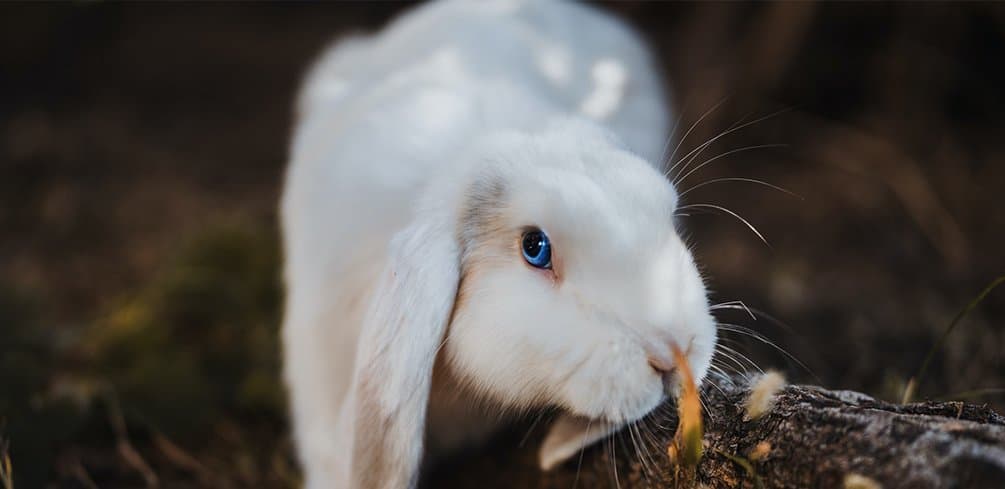Dogs and rabbits don’t naturally get along because dogs are predators, and rabbits are prey in the natural order of things. There are some breeds of dogs that aren’t aggressive towards rabbits, and they are usually smaller. However, pet owners can teach a dog and rabbit to cohabit in the same home peacefully.
Many pet owners have a variety of pets. You may have a dog and a rabbit, and ensure the dog doesn’t chase your rabbit around the yard. This article explains why dogs and cats don’t get along and how you can teach your dog to be gentle with the rabbit.
Why Don’t Dogs And Rabbits Get Along?
Dogs have an instinct to hunt prey even though they are domestic animals. Seeing a rabbit in your house or yard triggers those hunting instincts. Even the gentle dogs may attempt to chase and catch your pet rabbit when you let it loose. It’s in their natures.
Rabbits are prey, and in the wild, they are food for predators. Your pet rabbit will probably run and hide from your dog out of instinct. Moreover, the rabbit may not come from the hiding place until it is sure that the dog is gone for good.
Therefore, you need to be careful about introducing both pets to each other to ensure none of them gets hurt in the process. Also, don’t introduce pet rabbits to aggressive dogs like bulldogs and German shepherds. Try gentler dogs like Maltese or Golden retriever.
Risks of Introducing Pet Rabbits to Dogs
There are several risks to introducing your pet rabbit to your dog. Even though you want all your pets to get along, you should be cautious when having a dog and rabbit in the house. Dogs can bite and injure rabbits in an attempt to capture them. Also, they can scare your pet rabbit to death, especially the incredibly aggressive breeds.
Some dogs may be friendly, but they can also hurt a rabbit when playing. Rabbits are significantly smaller than dogs, and a friendly shove can be harmful to a rabbit.
More giant rabbits or insecure ones can attack a dog and hurt it. Rabbits have sharp nails that can dig into the skin of a dog and cause panic. Therefore, there is a safety concern for the rabbit and dog as you do the introduction.
How to Introduce a Rabbit to a Dog?
Many pet owners suggest introducing rabbits to puppies as a safe method. However, puppies are active, and they may hurt a rabbit unintentionally while looking for a partner to play with at home. Here are the steps you should take when introducing your pet rabbit to your dog.
Safe Introduction
The first encounters between the dog and rabbit should be from a safe distance for that the rabbit doesn’t run to hide. It would be best if you had the dog in an enclosure to prevent hurting the rabbit. Keep a safe distance between the two even when the dog is behind a partition.
Start by bringing the rabbit close to the enclosure where the dog is held and watch the interaction. Keep a close eye on the first encounter and take the rabbit away if you notice any signs of distress in either animal. Repeat the process during the coming days until there are no signs of pain in either animal.
The dog shouldn’t bark or try to pounce on the rabbit when it is in the open. You will know your pet rabbit is comfortable when it moves towards the dog without fear. Also, it will walk around the area without running to find a hiding spot. At that point, both pets are ready to progress to the next step.
Supervised Interaction
The next step is to let your dog and rabbit interact without the safety of an enclosure. You should be present the whole time to prevent the occurrence of an incident between the two pets. Keep the dog on a leash and discourage it from pouncing on the rabbit. If the dog is aggressive, you need to remove it from the room as soon as possible.
Each session should start with the dog sitting as you hold the leash. Release the rabbit and keep both animals calm until the rabbit approaches the dog. If you notice any signs of distress in either animal, stop the interaction and try another day.
It would help if you exercised patience, and it may take several trials for the dog to sit calmly and watch the rabbit. It will take a while for both animals to learn how to interact face to face without your dog chasing the rabbit. When both animals learn to interact under supervision, it is time for the last stage of training.
Free Interactions
The final stage is free interaction between your pet rabbit and dog. It would help if you were 100% sure that neither animal will hurt the other during an exchange. Start with short interaction periods and keep an eye on the pets. You can increase the periods each day when you notice that the pets get along just fine. Always provide supervision when you let a rabbit and dog interact with a leash or barrier.
My Dog Won’t Get Along with My Pet Rabbit
Some dogs will not even complete the first step of the training because they are aggressive. Not all dogs can interact with rabbits peacefully. If that is the case, you should always ensure that the rabbit is safe. Aggressive dogs can severely harm your rabbit if you don’t keep a close eye on them.
Is It a Good Idea to Have a Dog and Rabbit for Pets?
Many pet owners have dogs and rabbits. Some of them don’t let the two animals interact, and others do not. You won’t know whether your dog will be welcoming to your pet rabbit until you introduce them. Some of them can get along fine while others will not, and you have to keep the rabbit at a safe distance.
Conclusion
Dogs do not naturally get along with rabbits, but you can train your dog to get along with your pet rabbit. It is a journey that will require patience until the rabbit is comfortable interacting with the dog. You have to train your dog not to be aggressive towards the rabbit if you want them to cohabit peacefully.
Avoid bringing a pet rabbit home if you have an aggressive dog breed. Such breeds can severely injure a rabbit when they interact freely. In some cases, a rabbit can harm a dog. Therefore, you need to be vigilant on the safety of both pets when training them to get along.
Please be careful and use at your own risk
None of the authors, contributors, administrators, or anyone else connected with PetNudge.com, in any way whatsoever, can be responsible for your use of the information contained in or linked from these web pages.

